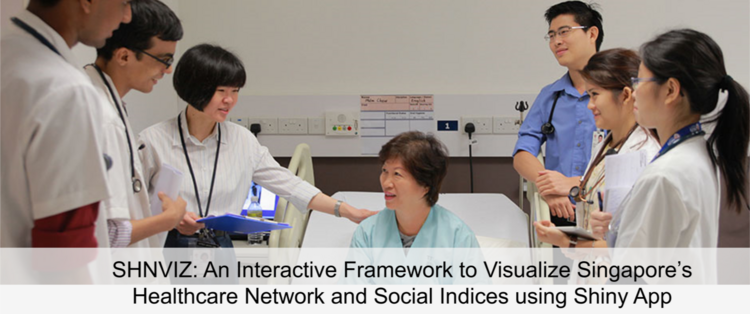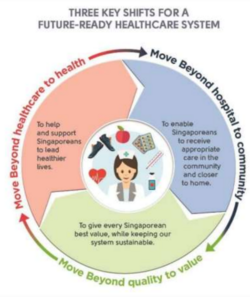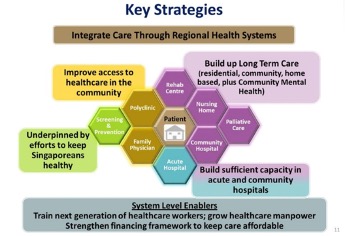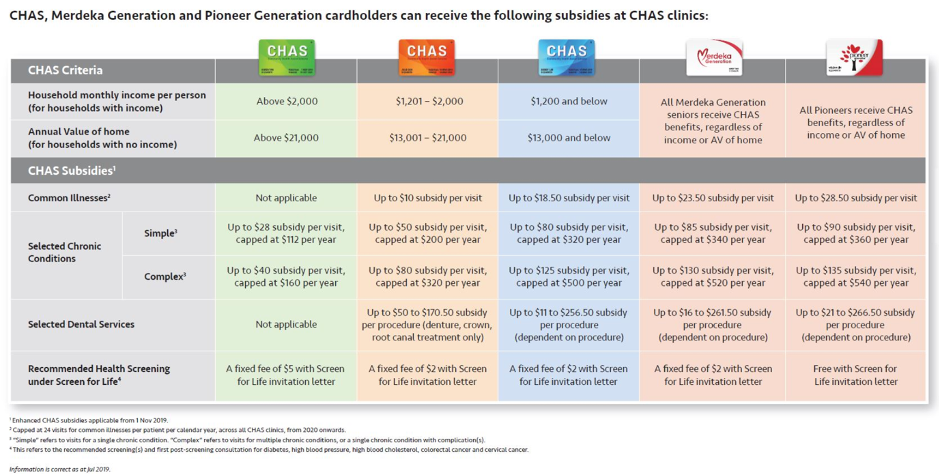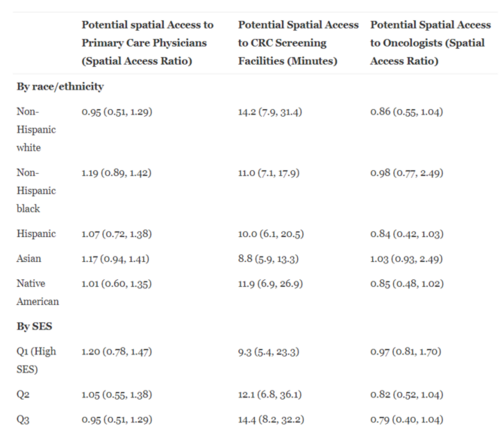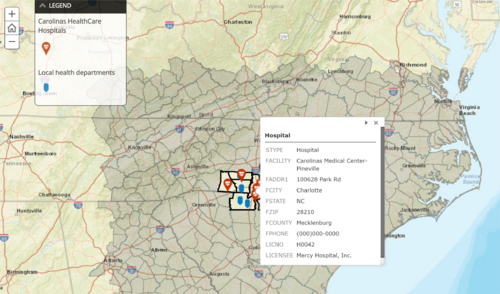Difference between revisions of "Group05 proposal"
| Line 48: | Line 48: | ||
===Motivation=== | ===Motivation=== | ||
| − | + | Whilst Singapore has one of the best healthcare system in the world (ranked #6 globally by the WHO), it scores highly on efficiency but not so on availability and equity. This is exacerbated by the increased strain on the capacity of the systems by aforementioned challenges, which points to an important aspect of well-being that needs to be critically examined. Using R Studio’s Shiny App as the basis of our interactive framework, we develop a series of dataviz tools to enable the user to explore the central theme of healthcare equity and availability in Singapore and its dynamic relationship with other economic and demographic measures. | |
| + | |||
| + | Our research and development efforts were motivated by the lack of an interactive public healthcare tool that integrates GIS information to encourage greater research and discussions in the public domain on the prevailing healthcare system. Existing works have often focused on a static analysis of healthcare financing, delivery and economic growth at the national level and few have sliced the national pie into its constituent planning areas for a deeper analysis. Therefore, our tool aims to bridge this analytical gap by: | ||
| + | 1) Displaying a cartographical breakdown of healthcare network (primary, tertiary, nursing homes) on an internet map like Openstreetmap; | ||
| + | 2) Layer on relevant demographic data like age and income distributions to facilitate policy planning; | ||
| + | 3) Create a user-centric tool to display closest healthcare facilities within a 2km radius; and | ||
| + | 4) Determine associative relationships between the healthcare network and socio-economic indices like income inequality etc. | ||
==Objective== | ==Objective== | ||
Revision as of 13:09, 26 April 2020
|
|
|
|
|
|
Contents
Introduction
Singapore has experienced significant economic growth since its independence, however, there are growing signs of social inequality and deterioration of societal well-being. Singapore’s ageing population resulting in a decreasing economic dependency ratio has placed a significant burden on the healthcare system. Our project aims to develop a data-driven decision support tool for policy-makers and analysts to explore relationships pertaining to healthcare equity and availability in Singapore. This includes a geo-spatial break-down of Singapore's income, demographic and healthcare availability indices to draw associative relationships as well as a postal-code based dynamic tool that fetches information on the nearest healthcare facilities. This aims to enable policy-makers to answer questions pertaining to the demand-supply dynamics of meeting healthcare needs and pinpoint locations where infrastructural gaps may exist.
Background
Overview of Singapore's Healthcare Landscape
Singapore is one of the most developed state in Asia and the world (as measured by GDP per capita). Its healthcare spending per capita is one of the highest in Asia and the world, which means that the majority of the population is likely to enjoy good quality healthcare.
The Ministry of Health (MOH) aims to ensure quality and affordable basic medical services for all Singaporeans, such that all aspects of the population have access to these services in a timely, cost-effective and seamless manner. Singapore's healthcare system comprises of two key pillars: the physical networks of primary, intermediate and long-term care (ILTC) services and a means-tested financing framework commonly referred to as the "subsidies + 3M" framework.
Singapore’s healthcare system is designed to ensure that everyone has access to different levels of healthcare in a timely, cost-effective and seamless manner. The key policies enabling this includes:
- Improving access to healthcare in the community: Increase acute beds by 1,700 and community hospital beds to 3,000 by 2020, Investment in primary care infrastructure (polyclinics, community health centres)
- Enhancing key enablers including technology and manpower: Adding 30,000 more healthcare workers by 2020 and adopting digital technologies such as AI
- Strong financing policies to ensure healthcare costs remain affordable to the masses. This includes policy packages like the Pioneer Generation Package (subsidies for elderly medical care), MediShield Life (universal insurance coverage) and the Community Health Assistance Scheme (means-tested subsidies on primary care).
Motivation
Whilst Singapore has one of the best healthcare system in the world (ranked #6 globally by the WHO), it scores highly on efficiency but not so on availability and equity. This is exacerbated by the increased strain on the capacity of the systems by aforementioned challenges, which points to an important aspect of well-being that needs to be critically examined. Using R Studio’s Shiny App as the basis of our interactive framework, we develop a series of dataviz tools to enable the user to explore the central theme of healthcare equity and availability in Singapore and its dynamic relationship with other economic and demographic measures.
Our research and development efforts were motivated by the lack of an interactive public healthcare tool that integrates GIS information to encourage greater research and discussions in the public domain on the prevailing healthcare system. Existing works have often focused on a static analysis of healthcare financing, delivery and economic growth at the national level and few have sliced the national pie into its constituent planning areas for a deeper analysis. Therefore, our tool aims to bridge this analytical gap by:
1) Displaying a cartographical breakdown of healthcare network (primary, tertiary, nursing homes) on an internet map like Openstreetmap;
2) Layer on relevant demographic data like age and income distributions to facilitate policy planning;
3) Create a user-centric tool to display closest healthcare facilities within a 2km radius; and
4) Determine associative relationships between the healthcare network and socio-economic indices like income inequality etc.
Objective
To assess the status of Singapore’s availability to healthcare based whether the existing healthcare facilities and social support meets the demands of the poorer income groups and ageing population. Based on the results, we hope to conclude that either (a): There is no significant difference in accessibility despite geographical differences in income and age groups across the island or (b): there is significant difference in accessibility correlating to geographical differences in income and age groups across the island.
Visual Data Exploratory
- Develop a visual layout of Singapore’s wealth distribution (monthly household income) on a geospatial basis
- Layer on age distribution across the planning areas
- Develop a visual layout of Singapore’s healthcare network (primary, tertiary, community, aged homes) on a geospatial basis
- Explore mapping over elderly friendly zones / wheelchair friendly zones that allow elderly access to nearest healthcare facilities
- Explore availability of further social support including but not limited to Family Service Centres, Resident Centres.
- To highlight primary care facilities with lower income social support such as CHAS, PG etc.
Interactive Visualisation Result
From policymaker point of view:
- oversight of healthcare and social support demand vs. healthcare supply and facilities
- able to pinpoint locations whereby there may be healthcare availability gaps
From everyday Singaporean point of view:
- overview of all healthcare facilities providing all levels of care
- able to toggle to the nearest healthcare facility
- able to view the social support provided in the planning area
Literature Review
| Index | Topic |
|---|---|
| Methods to measure spatial access to health services | According to Wan et al (2012), access to medical services refers to a person’s ease of obtaining health-care services that can bring about the best possible health outcome. Access can be classified into spatial and non-spatial access, for which examples of spatial access are like location and travel distance while non-spatial ones are like socio-economic status (SES), health insurance and cultural background.
The paper goes on to describes a series of methods that have been developed to measure spatial access, including but not limited to the regional availability method, kernel density models and gravity-based models. The paper critiques a drawback of the enhanced 2-step floating catchment area (E2SFCA) method and suggests that the spatial access ratio (SPAR) method was more effective. The paper concludes that the SPAR method, a relative spatial access assessment approach, was more stable to the variation of distance impedance as compared to previous methods and hence a more robust method to measure spatial access to health services. Our team will take into consideration these various spatial methods developed to construct/inform/reference our own spatial access index. |
| Geo-spatial interactive map | The North Carolina Institute for Public Health (NCIPH) developed a geo-spatial interactive map on the Carolinas Healthcare System. The tool assesses 12 Social Determinants of Health (SDOH) indicators at the neighborhood-level within their 10-county service region. The tool will enable policy-makers and healthcare administrators better understand the factors determining healthcare quality in the relevant planning regions. We will review the tool to adapt relevant features into our own geo-spatial tool. |
Tools & Package Used
| S.No. | Packages | Purpose |
|---|---|---|
| 1 | Shiny | For creating R shiny interfaces |
| 2 | Tidyverse | Collection of R packages for data analysis, packages includes ggplot2, dplyr, tidyr, readr, purrr, tibble, stringr, forcats |
| 3 | Httr | For working with HTTP |
| 4 | Leaflet | For creating interactive maps |
| 5 | PASWR | Allows for statistical commands to be executed in R |
| 6 | Janitor | Provides additional tools to examine and clean dirty data |
| 7 | Plotly | Creates interactive web graphics |
| 8 | Sf | Provides a standardized way to encode spatial vector data |
| 9 | Tmap | Thematic maps to visualize spatial data distribution including choropleths and bubble maps |
| 10 | Geojsonio | Converts data from and to 'GeoJSON' or 'TopoJSON' |
| 11 | Rgdal | Provides bindings for the 'Geospatial' Data Abstraction Library |
| 12 | Reldist | Relative distribution methods used to calculate Gini Coefficient |
| 13 | Viridis | Default color maps from 'matplotlib', a popular plotting library from python |
| 14 | shinyWidgets | Custom input widgets for Shiny App |
| 15 | Geosphere | The package implements spherical trigonometry functions for geographic applications. |
| S.No. | Packages | Purpose |
|---|---|---|
| 1 | Selenium | Web-based automation tool which can be used for crawling data |
Datasets Used
- List of clinics & hospitals: http://hcidirectory.sg/hcidirectory/clinic.do?task=load
- List of CHAS approved clinics: https://www.chas.sg/clinic_locator.aspx?id=90
- Resident Households by Planning Area and Monthly Household Income from Work: https://www.singstat.gov.sg/find-data/search-by-theme/population/geographic-distribution/latest-data > General Household survey > Resident Households > T152
- Singapore Residents by Planning Area, Subzone, Age, Gender & Type of dwelling: https://www.singstat.gov.sg/find-data/search-by-theme/population/geographic-distribution/latest-data > Population Trends > Singapore Residents by Planning AreaSubzone, Age Group, Sex and Type of Dwelling, June 2011-2019
- Masterplan 2014 Planning Area Boundary: https://data.gov.sg/dataset/master-plan-2014-planning-area-boundary-web
- Masterplan 2014 Subzone Boundary: https://data.gov.sg/dataset/master-plan-2014-subzone-boundary-web
Project Timeline
Team Members


Jiahao's Linkedin Pei Zhi's Linkedin Andrew
Reference
- WB (World Bank), 1985. World Development Report 1985. New York: Oxford University Press.
- Low, D., and Gill, A., 2014. Healthcare Financing: How Should Costs Shift from Private Pockets to the Public Purse? Lee Kuan Yew School of Public Policy, National University of Singapore.
- Low, D. and Vadaketh, S. T., 2014. Hard Choices: Challenging the Singapore Consensus. NUS Press.
- Low LL, Tay WY, Ng JM, M., Tan SY, Liu N, Lee KH et al (2018). Frequent hospital admissions in Singapore: clinical risk factors and impact of socioeconomic status. Singapore Medical Journal. 2018; 59(1):39-43.
- Chew YQ, A., 2018. The Hidden Costs of a Successful Developmental State: Prosperity and Paucity in Singapore. London School of Economics. March 2018.
- Abeysinghe, Himani and Lim, 2011. Equity in Singapore’s Healthcare Financing, Challenges for the Singapore Economy after the Global Financial Crisis. Wilson P. Singapore: World Scientific.
- Smith, Catherine J.; Donaldson, John A.; Mudaliar, Sanushka; Md Kadir, Mumtaz; and Yeoh, Lam Keong. A handbook on inequality, poverty and unmet social needs in Singapore. (2015). Social Insight Research Series. 1-86. Lien Centre for Social Innovation: Research.
- Interactive geospatial map developed by the North Carolina Institute for Public Health (NCIPH), 2012. Accessible via https://sph.unc.edu/nciph/gis/
- N.Wan, F. Benjamin Zhan, B.Zou and Edwin Chow (2012), A relative spatial access assessment approach for analyzing potential spatial access to colorectal cancer services in Texas. Applied Geography, Volume 32, Issue 2, March 2012, pp 291-299.
- WHO (World Health Organization), 2010. Monitoring the Building Blocks of Health Systems: A Handbook of Indicators and their Measurement Strategies.
- Khalik, S. (2020, March 5). New hospital in the east; Alexandra to be expanded. Retrieved April 24, 2020, from https://www.straitstimes.com/singapore/new-hospital-in-the-east-alexandra-to-be-expanded
- Primary Healthcare Services. (n.d.). Retrieved from https://www.moh.gov.sg/home/our-healthcare-system/healthcare-services-and-facilities/primary-healthcare-services
- The UK Healthcare system: http://assets.ce.columbia.edu/pdf/actu/actu-uk.pdf
- Overview of the Health System and Regulatory Landscape in Singapore, 24th EPSO Conference26 September 2017, Adj Assoc Prof (Dr) Raymond ChuaGroup Director (Health Regulation Group), Ministry of Health
- https://www.aic.sg/care-services/Community%20Health%20Centres
- https://www.mdpi.com/1660-4601/16/2/170
- https://www.mdmag.com/medical-news/us-ranks-29th-in-global-healthcare-access-and-quality-index
